
Making the switch
More and more people are switching their homes from gas to electricity.
It’s time to save money on energy bills, protect your family’s health, and take action for a safer climate.
Electric appliances are more efficient, save money, and do not release irritating indoor pollutants that exacerbate childhood asthma and and are associated with other health impacts.
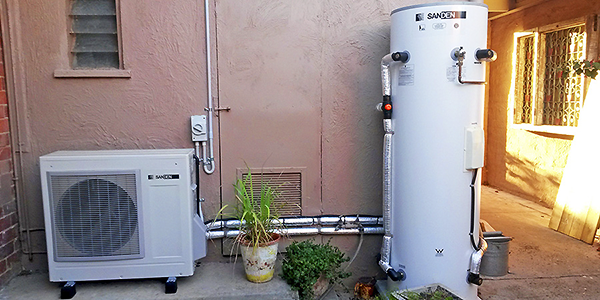
Hot Water
Replacing your gas hot water system with an electric heat pump, has lower running costs, reduces your energy bills and leads to significant savings in household emissions, particularly when coupled with solar PV or green electricity purchases.
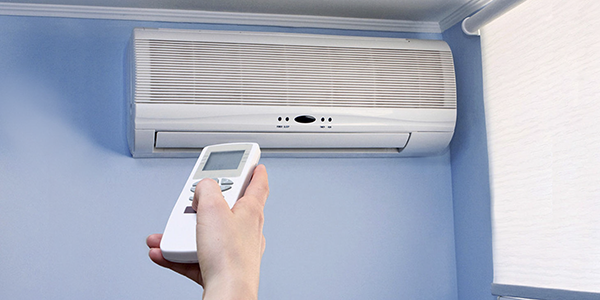
Home heating
Reverse cycle air conditioning for heating (and cooling) is safer than ducted gas heating, improves air quality, is better for your respiratory health, and saves hundreds of dollars per year in running costs.

Cooking
Induction cooking is very efficient with precise control of temperature and is safer than gas cooking. Often gas cooking is the last gas appliance to go, allowing householder to save hundreds of dollars each year from disconnecting from gas – and the cooktop is much easier to clean.
Protecting the planet
‘Natural’ (household) gas is a fossil fuel that releases greenhouse gas emissions.
Making the switch to clean electricity is a worthwhile contribution to a safer planet and a more sustainable future.
Download our PDF
Find out more and save time on research with our interactive pdf – dozens of resources from the Climate Council, Renew, Yarra Energy Foundation and more, including key health research and government resources.
Keeping your family healthy and safe
Electric appliances are healthier than gas appliances
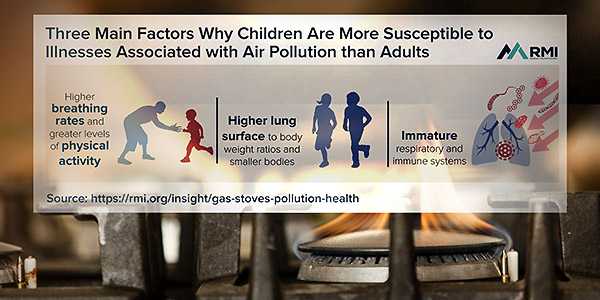
Indoor Pollutants
Electric appliances reduce indoor pollutants.
A RMI review found that gas stoves were associated with levels of nitrous dioxide (NO2) well above outdoor standards, including when the stove was not being used. RMI found that elevated NO2 levels from gas cooking are associated with cardiac and respiratory health impacts including asthma, and learning difficulties, and the effects of gas cooking impacted children more due higher breathing rates, higher lung surface to body weight ratios, and immature respiratory and immune systems.
More about indoor pollutants
“Cooking on a gas stove unleashes some of the same fumes found in car exhaust”, reports The Atlantic, detailing that an atmospheric chemist’s child’s asthma cleared up “almost overnight” with the shift from an all gas to an all electric home. The Atlantic also noted that the RMI report stated that homes with gas stoves have concentration of Nitrous Oxide (NO2) 50%-400% higher than all electric homes. NO2 is associated with wheeze, and higher levels of asthma. A Columbia University study found that switching to induction cooking reduced NO2 levels by 50%.
Other pollutants include NO, carcinogens formaldehyde and polycyclic aromatic hydrocarbons (PAHs), and carbon monoxide. Gas heaters are associated with an increase in acute respiratory infections.

Childhood asthma
Electric appliances reduce the risk of childhood asthma.
University of Queensland research found that gas cooking is causally implicated in 12% of childhood asthma – this was further publicised through a Climate Council report. Asthma Australia is informing parents about the risks of gas cooking. A US meta study found that gas cooking accounts for 12.7% of childhood asthma.
More on childhood asthma risk
An epidemiological meta-analysis found that “children living in a home with gas cooking have a 42% increased risk of having current asthma, a 24% increased risk of lifetime asthma”, with wheeze being associated with increased NO2.
The Climate Council reporting on an environmental health study on gas stoves states “more than half of occupants with were routinely exposed to harmful levels of NO2 and formaldehyde” if used with poor ventilation, and cites two other US studies to conclude “indoor NO2 pollution from gas stoves often reaches levels that would be illegal outside.” NO2 exposure is significantly associated with childhood asthma.
“Gas cooking and heating” is also associated with “accelerated lung function decline” in middle age, according to an ongoing longitudinal Australian study.

Developmental risks
Electric heating and cooking reduces risk.
The Climate Council notes that evidence has been growing about “the risk of combustion-related air pollution to a child’s neurological development, including the many combustion related pollutants associated with household gas use” and concludes “Being exposed in early childhood to unhealthy air – whether indoor or outdoor – may have a profound impact on an individual’s life prospects, with cognitive impairment going on to affect school performance and other opportunities.”
More on developmental risk
“Evidence linking combustion-related air pollution with adverse neurodevelopment is mounting” a neurodevelopmental meta study states, linking “combustion-related air pollutants (PM2.5, polycyclic aromatic hydrocarbons, nitrogen dioxide, black carbon) with adverse effects on brain development, including deficits in intelligence, memory, and behaviour” including “developmental delay; reduced IQ; symptoms of anxiety, depression, and inattention; ADHD”. Although this study focusses on external air pollution, gas cooking and heating releases similar pollutants and has been linked to cognitive impacts including ADHD. Gas cooking has been found to have a measurable impact on a mental development score in a prospective study.
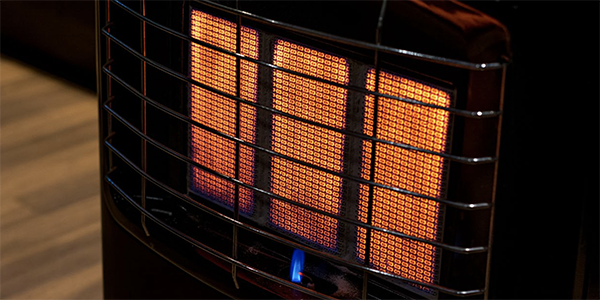
Carbon Monoxide poisoning
Gas cooking and heating increase interior CO levels.
CO poisoning is the leading cause of poisoning world wide, has significant neurological and cardiac sequelae, and is an avoidable cause of death. Gas heater usage increases the risk of carbon monoxide poisoning, particularly with unflued, or poorly maintained gas heaters. Gas cooking is associated with increased CO levels. Long term CO exposure is associated with difficulty in thinking, brain damage, heart impacts, and may be associated with neonatal impacts (p186). A NSW Government fact sheet notes “Electric heaters produce no indoor air pollutants.”
More on carbon monoxide risk
Vanessa Robinson bravely tells the story of the impact of a faulty gas heater on her family in this Climate Council report (pp. 31-32).
Carbon monoxide binds with haemoglobin, preventing the red blood cells from carrying oxygen. At high concentrations death can occur in as little as several minutes. Unflued gas heaters are still used in many schools, particularly in NSW, and are associated with increased respiratory health impacts including asthma. Do not use gas heaters in children’s bedrooms or leave gas heaters on overnight. Long term, low level CO exposure is associated with neurological impacts – gas heaters should be regularly maintained by a licenced gas-fitter every two years.
Switching to electric appliances protects against short term as well as long term carbon monoxide risk.

Heart health risks
Gas appliances are associated with elevated CO, NO2 and PM2.5 levels.
Elevated short term CO levels are associated with increased cardiac disease according to the EPA: “a causal relationship is likely to exist between relevant short-term exposures to CO and cardiovascular morbidity.” (p. 5-48) Gas heaters need regular maintenance to reduce carbon monoxide leaks. Gas cooking has also been linked to cardiovascular impacts through long-term low level CO exposures. The EPA states that long-term NO2 exposure is associated with “cardiovascular effects, diabetes, poorer birth outcomes, premature mortality, and cancer.”
More on heart impacts
A California study showed that gas cooking was “typically used” without rangehoods, and that in this case over half of occupants would be “routinely exposed to NO2 [and] HCHO [formaldehyde] levels that exceed acute health-based standards”, in other words, worse than legally enforceable EPA standards for outdoor pollution. One problem is that effective rangehoods are very loud, and are often not turned on.
A article on the RMI review states that “elevated NO2 levels have also been linked to other conditions such as cardiovascular problems, diabetes, cancer, reproductive issues and brain development in children.” Fine particle pollutants (PM2.5) is also associated with gas cooking. PM2.5 is associated with increased “all-cause and cardiovascular mortality”, and PM particles “play a significant role in cardiovascular disease”…where PM2.5 is associated with fuel combustion.
A study by UCLA Fielding School of Public Health states replacing all gas appliances with clean energy appliances in California would save “approximately $3.5 billion in monetized health benefits for just one year.”. Most of this saving would come from “the reduction of secondary nitrate fine particulate matter (PM2.5) [from nitrogen oxides (NOX)] and primary PM2.5”.

Long term health impacts from fossil fuels
Electric appliances are cleaner.
The Lancet says that the climate crisis will have profound affects on our health: “The current impacts and future risks of climate change caused by human activities far surpass those of any other force” and “climate change will challenge the very essence of children’s rights to survival, good health, wellbeing, education, and nutrition”.
Households who switch from gas to clean, electric appliances support climate action and reduce emissions, helping to protect our children’s future from the health impacts of the climate crisis.
More about long term health risks from the climate crisis
A Special Report on the climate crisis and health with contributions from over 80 eminent experts from COP24, states that “Climate change is the greatest challenge of the 21st century, threatening all aspects of the society in which we live, and the continuing delay in addressing the scale of the challenge increases the risks to human lives and health” and “Climate change threatens to undermine over half a century of global improvements in health achieved with dedicated, targeted action by policy-makers and the health community.”
The Climate Council’s report on heatwaves says that that the steady increase in summer mortality suggests that “climate change may already be affecting mortality rates” and an APA Report looks at the increasing mental health implications of fossil fuel caused climate damage.
A Sierra Club study shows climate benefits across the US for a switch to electric heat pumps despite varied levels of renewables in the various electricity systems.
In Australia, public health and climate peak body CAHA has published numerous papers and reports including a recent briefing paper for a vision for a better future:
“A healthy, regenerative and just future is available to us. It is scientifically, economically, culturally, socially, and technologically feasible.
“This future is one that benefits everyone. Achieving it however means we must acknowledge and face up to uncomfortable truths: that our current economic system, focussed on growth … is deeply counterproductive. And that left unchecked, our current trajectory poses existential threats to humanity i.e. it threatens the survival of billions of people around the globe, and the continuation of civilised, and peaceful, human societies.”
“Achieving this future will require transformation of our energy and transport systems, housing and infrastructure, urban planning, food systems, and governance.
“The good news is, if implemented, these measures will help us tackle both the climate and biodiversity crisis, and deliver significant public health, economic, and environmental benefits.”
Switching to electric cooking, heating and cooling protects your family’s health and the health of the planet too.
- Using your range hood, and/or opening doors and windows when using a gas stove is partially protective.
- Consider purchasing a portable induction burner and using your microwave more often during the transition period.
Want to be involved in local climate action?
You can:
- Come to a Lighter Footprints event
- Join one of our Working Groups
- Donate to Lighter Footprints
- Sign up below to our newsletter.
Further Information
- Gas vs solar – and Household Fuel Choice Report
- Free Solar and Battery Advice based on Renew’s Sunulator tool
- An accessible guide to putting on solar, including contracts
- Community battery Solar Sponge collaboration with United Energy, including ANU provision of software
- Why gas is bad for climate and energy prices explainer
- The benefits of living in a gas-free home explainer
- Kicking the gas habit: how gas is harming our health report
The Australia Institute
TAI is a high impact thinktank, with an engaging seminars/webinars, research and reports.
- Wrong Way, Go Back report on the Gas-fired Recovery
- Weapons of Gas Destruction lifting the lid on gas emissions
Climate and Health Alliance
CAHA is a coalition of health care stakeholders working on climate. CAHA publishes many useful resources including on health impacts of climate change, climate action health co-benefits, a memorable look at different post-pandemic futures set in 2030.
Acknowledgements
We acknowledge our debt to the Conservation Council ACT Region’s Make the Switch website. The original printed version of this interactive pdf was produced by the Cooper Climate and Environment Reference Group in March, 2021. Lighter Footprints has reviewed and endorsed this leaflet.
However, please note that whilst Lighter Footprints has endeavoured to ensure all information is correct, individual circumstances will vary and it is important that you undertake your own research to best cater for your preferences and situation.
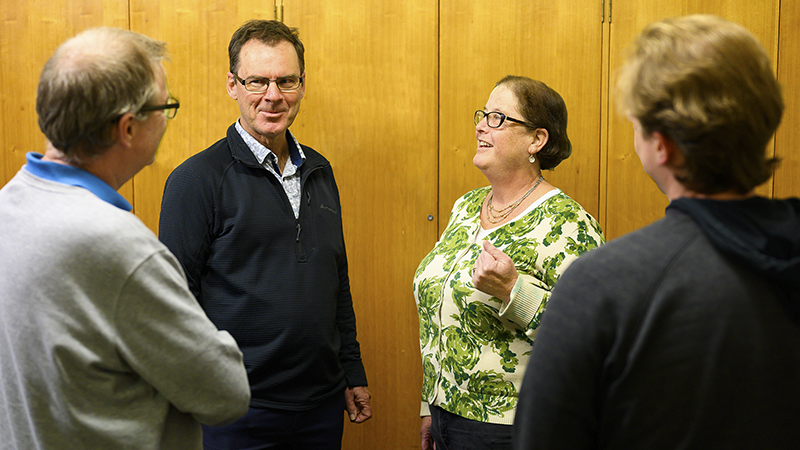
Sign up to our newsletter
to receive news and updates about effective local climate action

